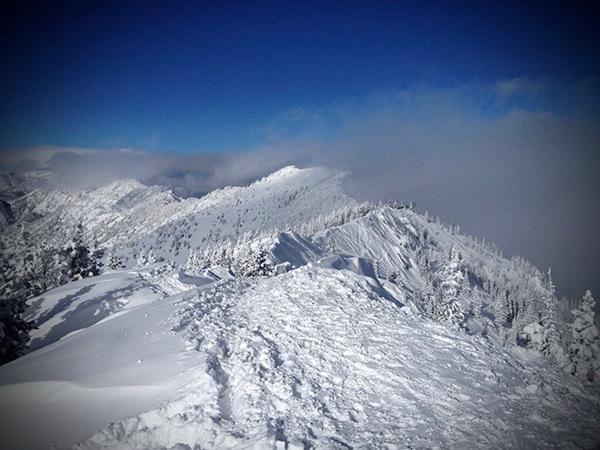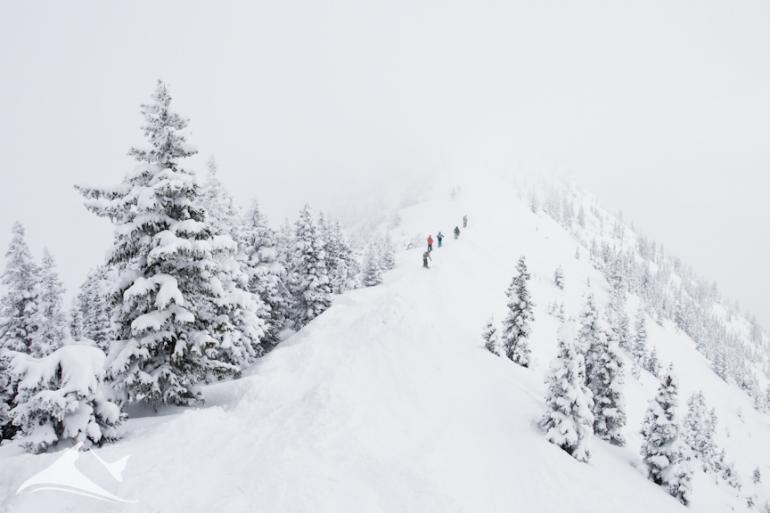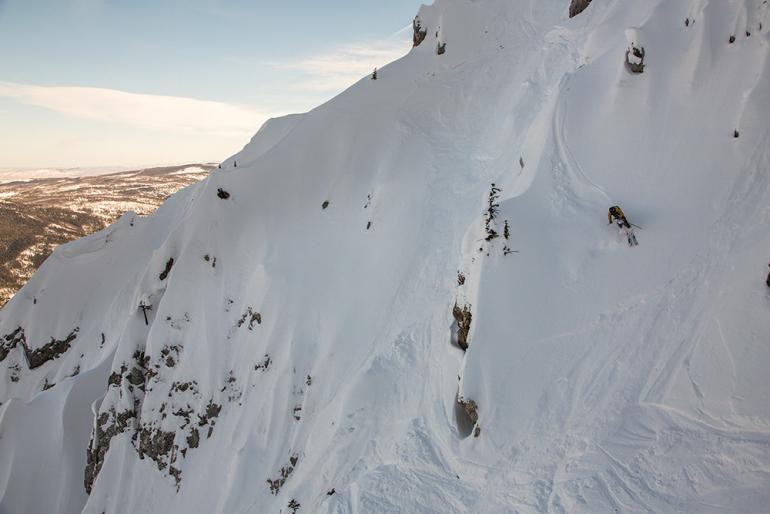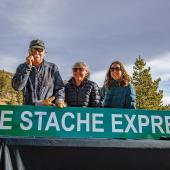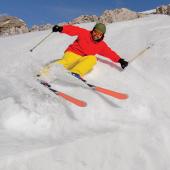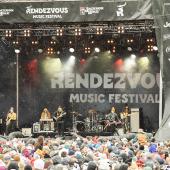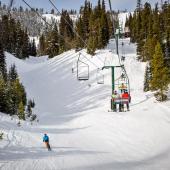A Ridge Too Far
Decades of wonder lead to a satisfying culmination.
It was one of those days you might hear about at an AA meeting, the kind of nine-to-five-career-ending day that is the lore of many a mountain town across the Northwest. After nearly three weeks of clear skies, the clouds rolled in and dumped two feet of snow overnight. On a Wednesday.
So I did what any sane, rational, completely irresponsible ski-town resident would do. I called in sick.
No coffee today, thank you—giddy enough with anticipation of fresh tracks and snow-gulping face shots. As I prepared my gear, carefully double-checking for oversights, a thought intruded: Today is the day. "Nah, not today," I answered aloud. It persisted: Yes, today is the day.
All right, then. Today would be the day. Today I would end the ambition-sapping chairlift roosting routine. Today I would satisfy an old and persistent hunger. Today I would ski the Ridge.
Not that it would be any kind of record-setting achievement; hundreds of people do it every day. But for me, twenty years after first laying eyes on its sprawling silhouette, watching skiers carve sweet turns down its white slopes, skiing the Ridge was more than just another off-piste endeavor. It was a culmination.
It started back in the late '70s. On weekends, my brother and I would wave to Mom as we loaded the bus to Bridger Bowl. Following our Mighty Mites instructor down the ramp at the Bridger Lift halfway point, we saw the Ridge-bound skiers who waited above to load our chair. To us, they looked like modern-day knights – thick, frosty beards, high-tech transceivers strapped across their chests, shovels sheathed in tough-looking backpacks. They joked and swapped stories, laughing in deep, confident voices. As their towering forms loaded the chairlift, we stopped and stared, eyes wide and mouths agape.
A couple of years later the family moved away to warmer climes, and water-sport enthusiasms soon edged out the hard-to-satisfy skiing bug. Our skis were relegated to garage-corner coat racks. The fire never died, though, and ten years later I was back in Bozeman, a wet-behind-the-ears college freshman, eager to once again point my 1975 Rossis down Bridger Bowl’s familiar slopes.
That winter was cold. For over a week the entire university shut down. Pipes froze, cars wouldn’t start—everyone just holed up and waited. My roommate and I, stuck in Langford Hall dormitory with hundreds of other bored freshmen, nearly went mad with cabin fever. One can only watch so much TV with pimple-faced college kids before a re-enactment of A Texas Chainsaw Massacre seems the only logical course of action.
When the cold spell finally broke, we flushed the fever by skipping class and skiing every day. The Ridge was open, of course, but we never dared ski it. After all, we were intermediates, still learning to hold our own on the steeps and in the mogul fields. Quick, confident turns, fresh tracks, and 45-degree chutes lived only in our imaginations, on a vague and distant alpine horizon. Besides, what college freshman can afford a $200 transceiver?
We watched the Ridge skiers. To us, they were the demigods of Bridger Bowl, those preternatural pistons in the Great Engine of Skiing: they inspired us, gave us a goal, kept us going. As they threw their skis over their shoulders and marched upward toward the Elysian Snowfields, my roommate and I watched with wide eyes. We dreamed of the day that we would become like them, the day that we would ski the Ridge.
Slaves to these dreams, we filled our dorm room with old walkie-talkies and CBs from the pawn shop downtown. If we couldn’t buy transceivers, then damnit, we would build them ourselves. Gary, a mechanical engineering major who lived next door, thought we were complete idiots. One day he stopped outside our "laboratory." Peering from one pile of alarm clocks and portable radios to another, he could barely contain himself. "You know," he said between giggles, "you guys should start your own company. You could call it WCI—Worthless Crap Incorporated." His raucous laugh rose to an echoing crescendo, and then suddenly cut short. "Hey! Is that my Walkman?" We slammed the door, locked it, and dissected Gary’s radio.
I moved away two years later, again to flat terrain and a snowless climate. This time I kept skiing: winter vacations to Snowbird, Alta, Jackson Hole, and half a dozen other resorts in as many years. Over time, I learned how to do what I’d watched the Ridge skiers do for so many years: tear up the steeps, hop down chutes the width of a waterslide, and float through powder with stamina and grace.
The last winter of the 20th century found me headed back to Bozeman again, with Ridge skiing on the brain. But I returned to find that it had almost become passé. A Rolling Stone feature article about the Bridger Ridge and a recent surge in extreme-skiing popularity had combined to produce an entirely different Ridge than the one I’d grown up revering.
No longer reserved for the hardy few, for the determined and capable Bridger Bowl elite, the Ridge now saw upwards of 500 hikers a day, many of them making four or five laps before day’s end. What used to be a refuge for powder at 2pm now followed the same rule as any other area: get there early if you want fresh tracks.
But the Ridge’s newfound vogue hasn’t necessarily reduced its appeal to seasoned expert skiers. I remember meeting a Grand Targhee ski patroller two years ago as my brother and I hiked to a sweet out-of-bounds run above the upper lift. Targhee boasts kick-ass terrain and an average snowfall of 500 inches a year—more than any other ski area in the lower 48—but this gal couldn’t stop talking about Bridger. "Targhee’s great," she said, "but it doesn’t have a Ridge."
Well, Bridger Bowl did, and passé or not, I was going to ski it today. I called Jeff, an old skiing partner, at 7:00 a.m. “Let’s ski Bridger today,” I told him. “I want to do the Ridge.” He laughed. “Is today the day? Are you sure you’re ready for this? I mean, it’s only been 20 years, you know.”
“I know, I know,” I said, “Can you get me a transceiver?” Another chuckle. “What about your Rube Goldberg contraption?” (I had, during a rare nostalgic moment, made the mistake of showing him one of my useless makeshift beepers from the old Langford Lab.) “I have a special high-capacity backpack that might hold it,” he offered. “Shut it,” I said. “I’ll be over in a few minutes.” By 8am we were on the road to Bridger Bowl, two transceivers and two avalanche shovels in the back seat.
The ride up Bridger Lift seemed like it lasted an hour. I’d just pulled up my hood against the wind when the lift shack came into view. The Ridge loomed large above us, tall and austere like the white cliffs of Dover. “She’s looking good today,” said Jeff, his eyes tracing the ridgeline. “Let’s do it.”
So we kicked off our skis, strapped them to our packs, checked our beepers at the gate, and we hiked. We hiked straight up, into the bright cerulean sky and the brisk morning air. Snow crystals leapt off sagging pine boughs and flew into our faces. I lifted my head, invigorated by the frosty sting. Fifteen minutes later we topped out, our breath steaming and swirling like campfire smoke. I turned around to see the Crazies looming in the distance, a heavy layer of snow blanketing the Bangtails, and a universe of virgin white to every side of me. Not a single track, anywhere. It was beautiful. Absolutely beautiful.
Trembling with excitement, I ripped my skis off my pack and clicked in. I followed Jeff along the north ridgeline, alternately coasting and sidestepping up the Ridge’s gentle contours. After a while Jeff veered right and casually slipped off the lip into a poof of white. I launched in after him, gulped a mouthful of powder, and then made some of the sweetest turns my body has ever produced—lift, shift, glide… lift, shift, glide. This, I think, is the essence of skiing: the pure and complete relation of your body to the physical world around you. You are no longer in control; you are assimilated, surrendering your individual strength to the collective, allowing all its power, all its energy, to flow through your own. You’re not even really skiing anymore; you’re flowing, like a piece of bark in a rushing stream.
The slope funneled us into a series of chutes and sheer cliffs. We stopped and looked around. There wasn’t another skier in sight. Dropping into the far-right chute, we glided smoothly, effortlessly downward. After about a dozen turns it opened up, and I followed Jeff on a slight traverse to the right. We danced through some trees and dodged a few big rock outcroppings, emerging into a beautiful little face of powder. "Even on a busy day," Jeff said, beaming, "you can always find these little pockets." He looked at the expanse of white below us, grinned, and motioned for me to go first.
I did, pointing my skis and floating, through the crystalline whiteness, down the perfectly-graded slope, my turns smooth and easy. The snow was so light and so deep I could do no wrong in it. Hero snow, as people call it. The powder sprayed up and into my mouth, but I couldn’t wipe the perma-grin from my face. I felt light and dreamy. As the mountain assimilated me, I caught a glimpse of a wide-eyed youngster on a distant chairlift. He tapped his friend and pointed at me. My mind drifted to a time ten years back, to cluttered dorm rooms and empty bank accounts, to ski lessons and endless winters and dreams as big as mountains. I let it all go and I flowed, down the rushing stream of snow, through the Ridge’s sloping glen, into a sea of eternal white.

